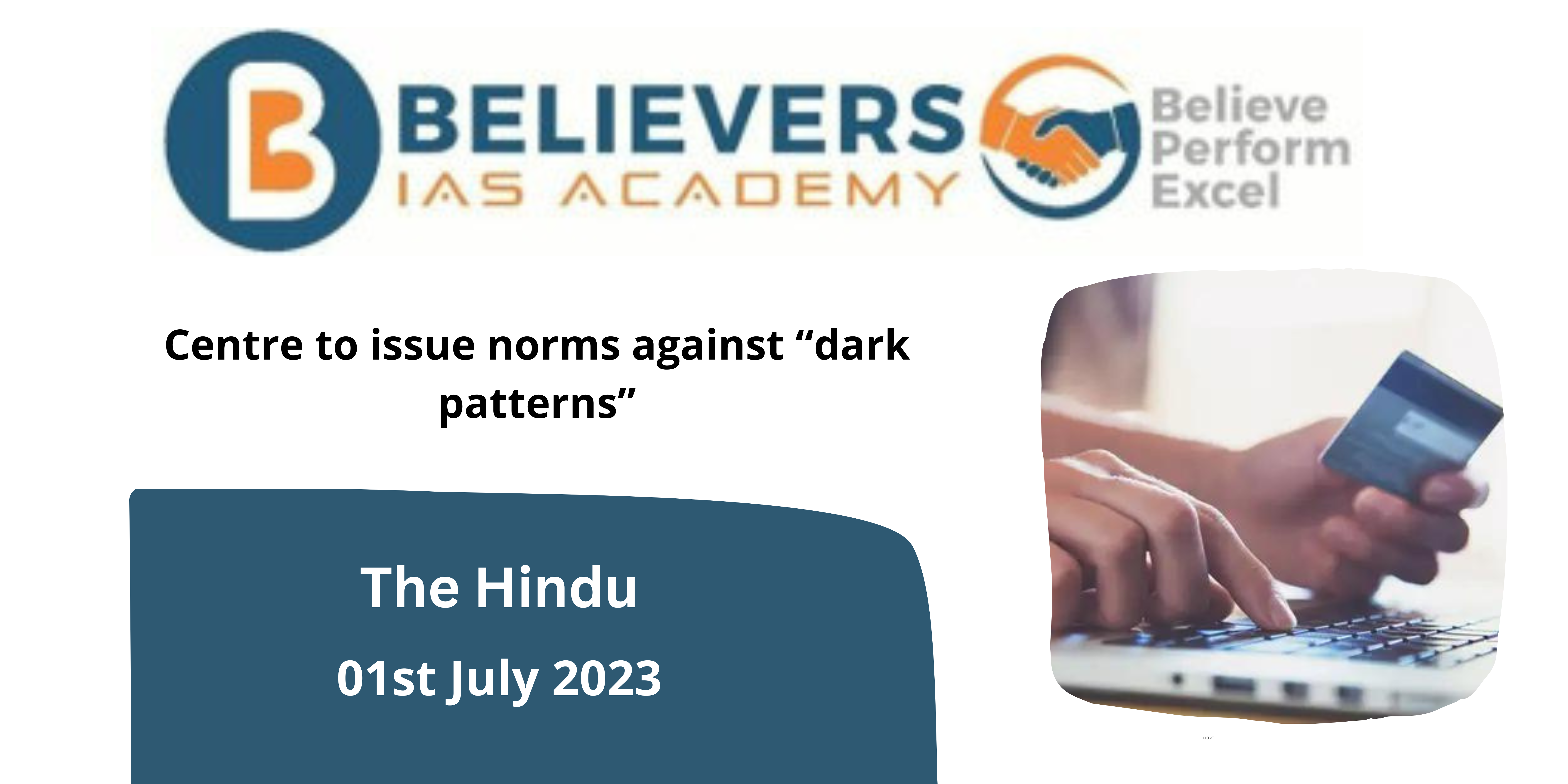Centre to issue norms against “dark patterns”
Context :
The Union Consumer Affairs Ministry has resolved to establish specific recommendations to limit the rising “dark patterns” of misleading marketing, creating fake urgency, confirm-shaming, forced action, subscription traps, and nagging on online platforms.
What are dark Patterns?
- Dark patterns are immoral user interface designs that are made to trick and manipulate consumers.
- They either complicate the user’s experience or make use of them to the advantage of the platform or business using them.
- Dark patterns limit consumers’ access to complete information about the services they are using and provide them less choice over their surfing experience.
- Harry Brignull, a UI/UX researcher and designer, first used the term “dark patterns” in about 2010.
- Dark patterns influence users’ behaviour or outcomes by making use of psychological biases and a lack of user knowledge.
- Websites, mobile applications, and email marketing are just a few examples of the different digital interfaces where they can be found.
- Dark patterns frequently influence people to act or make decisions that are not in their best interests.
- Examples of dark patterns include misdirection, hidden costs, forced continuity, roach motel, sneak into basket, privacy zuckering, and confirm-shaming.
How is it being used by Multi-National Companies?
- Dark patterns are design decisions made for user interfaces to deceive or coerce users into acting in ways they might not have otherwise. The user experience or privacy is frequently sacrificed to advance the business. Some of the instances you gave to show how certain MNC firms have come under fire for using dark patterns:
A)Amazon’s perplexing cancelling policy for Prime membership: Users found it challenging to cancel their memberships because of the lengthy procedure, which could have resulted in accidental renewals and extra fees. After coming under fire from EU consumer watchdogs, Amazon eventually made the procedure simpler for online shoppers.
B)Unsolicited sponsored communications from influencers on LinkedIn: Due to the complicated platform restrictions, it can be difficult to disable this option when influencers send users unsolicited messages. Users may find this practice intrusive and unpleasant.
C)Instagram’s Suggested Posts and Scattered Sponsored Video Ads: consumers complain about being offered suggested posts they didn’t want to see, and sponsored video advertising is strewn across Instagram in a way that deceives consumers before exposing their sponsored status. This interferes with the user experience and may be deceptive.
D)Pop-Ups obscuring the final seconds: YouTube’s pop-ups hide the last few seconds of films as a way to entice users to subscribe to YouTube Premium, which may irritate viewers hoping for a seamless viewing experience.
What potential losses do users face as a result of dark patterns?
- Confusing Users: Users are misled or confused by dark patterns, which are created specifically to do so. They might do this by using deceptive language, deceptive imagery, or ambiguous instructions to influence users to act inappropriately or make poor decisions.
- Online Obstacles: Online impediments can be introduced by dark patterns, which can make routine tasks more difficult and time-consuming for users. They can require numerous steps, a lot of form filling, or perplexing navigation, all of which might irritate consumers and prevent them from effectively reaching their goals.
- Unwanted Services and Products: Users are tricked into signing up for undesired services or items using dark patterns: Some sneaky tactics force consumers to join up for services or buy things they don’t need or want. To persuade users to make unintentional decisions, they can employ pre-selected checkboxes, deceptive descriptions, or hidden fees.
- Sharing more information than intended: Users are compelled by unintended dark patterns to spend more or divulge more sensitive information: Dark patterns might financially harm users or breach their privacy. They may utilise tricks to trick customers into spending more money or disclosing more personal information than they had originally meant, such as hidden fees, upselling techniques, or deceptive data-gathering practices.
- Dark patterns in developing technologies: According to the FTC report, if augmented reality (AR) and virtual reality (VR) platforms become more widely used, dark patterns could also start to appear in these brand-new channels. It emphasises the necessity of exercising caution and addressing any dark patterns that extend to developing technology.
What is India’s stand in curbing these practices?
- The rise of dark patterns on online platforms, which deceive users and breach their rights, has the Union Consumer Affairs Ministry concerned. They view these actions as being unfair business practices.
- Dark patterns have a severe impact on society, and governments around the world have put rigorous rules in place to prevent them. The Ministry considers that the Consumer Protection Act’s current rules are adequate to manage these difficulties, but specific guidelines will be released to effectively restrict dark patterns.
- The Ministry has written to significant internet platforms to warn them against using dark patterns in their user interfaces to engage in unfair business practices. The Ministry emphasises that these actions infringe on Section 2(9) of the Consumer Protection Act’s protections for consumers.
- The following are a few dark patterns that the Ministry is particularly concerned about:
A)False urgency is the practice of pressuring customers into making hasty decisions or purchases by instilling a sense of scarcity or time-sensitive offers.
B)Basket sneaking: Placing extra goods or services in the user’s shopping cart without their permission, may result in unexpected purchases.
C)Subscription traps: Making it simple to subscribe to services, yet challenging for customers to cancel or unsubscribe.
D)Hiding extra costs: It has been shown that some industries, including travel and tourism websites, hide extra prices, deceiving customers about the genuine cost of a good or service.




